We explore the unique qualities of the Galaxy Rasbora, a small, vibrantly colored freshwater fish. Known for its striking appearance, it features a constellation-like pattern of spots against a dark background, resembling a starry night sky. Ideal for community aquariums, these peaceful fish thrive in well-planted tanks that mimic their natural habitat. Care involves maintaining clean water and a diet of small invertebrates or quality flake foods. Breeding them can be a rewarding experience, with attention to water conditions and providing a safe environment for fry.
Table of Contents
Galaxy rasbora care
Galaxy rasbora fish are easy to care for, thanks to their peaceful temperament. They require a ten-gallon tank that can house at least 5 of these fish. Since they are freshwater fish, they need a warmer temperature of 72°F and a diet of fish flakes and micro worms.
Galaxy Rasbora Overview
The Galaxy Rasbora is a tropical fish that has remained a favorite amongst aquarists since its discovery in 2006. This fish is one of the latest additions to the aquarium trade that caused a great hit with fish keepers worldwide. The fish has got a fantastic coloration on its body, the reason why it is one of the most sought tropical fish for aquariums. Indeed its unique colors look so good that a section of fish keepers was skeptical of it and thought that the colors were sort of a ploy to hoodwink the public into buying it. Surprisingly, when seen in an aquarium, the fish looks even more stunningly beautiful than even from photos.
The name of the fish has just changed from Galaxy Rasbora to Celestial Pearl Danio. Researchers did this after they established that the fish is closely related to the Danios fish species. When the researchers first discovered the fish, it used to be called the Microrasbora sp. Today, its official name of Danio Margaritatus.
| Information Chart | Galaxy Rasbora |
| Scientific Name: | Danio Margaritatus |
| Family: | Cyprinidae |
| Care Level: | Easy |
| Temperament: | Peaceful |
| Color: | Red with white spots |
| Lifespan: | 3 to 5 years |
| Size: | Up to 1 inch long |
| Diet: | Omnivorous |
| Minimum Tank Size: | 10 gallons |
| Temperature: | 73 to 79 degrees F |
| Water Conditions: | pH 6.5 to 7.5, 2 to 10 dKH |
| Tank Mate Compatibility | Schooling fish |
Galaxy Rasbora Appearance

This fish has a bizarre body shape in comparison to other fish that it has close relations to. It has a nose that appears somewhat stumpy, with its body length being about three times that of its height.
There is a striking difference in the colors of the males and females. The males exhibit relatively bright blue body coloration with more coloration in their fins. Females on their part exhibit duller bluish-greenish background coloration with a tint of yellowish color to their bellies.
Both the female and the male sexes exhibit a pattern of what appears to be tiny dots on their bodies. The gill plates of both the sexes are so transparent that you can visibly see blood vessels through them.
They are more popular than other danios because of their attractive appearance.
The Lifespan of Galaxy Rasbora
The typical lifespan of a Galaxy Rasbora is 3 to 5 years. Galaxy Rasbora does not live very long. Living in large groups will increase their chance of living longer. They can live up to 5 years or a little more than that with reasonable care and water conditions.
Galaxy Rasbora Size
The typical Galaxy Rasbora grows up to 1 inch on the lower end and 1.5 inches for larger specimens. At birth, they are no more than a few millimeters. They are one of the smallest freshwater fish in size, and most never grow more than 1 inch.
Natural Habitat and Origin
The first discovery of this fish was back in the year 2006 in Asia, Myanmar, in an area near the Salween River Basin.
It is a tropical freshwater fish that is already on the list of quickly declining fish species. The declining number of fish populations is because of the enormous demand from aquarists and hobbyists alike. This has led to the destruction of the fish’s natural environment, usually resulting in over-collection, thus hindering its smooth breeding.
Galaxy Rasbora Care & Tank Set-Up
The Galaxy Rasbora is a small, peaceful fish that requires a well-maintained tank with plenty of plants and hiding spots. They prefer soft, slightly acidic water and should be kept in a school of at least 6 individuals.
The water conditions in the natural habitat from which the fish come from are usually slightly alkaline, and the temperatures there can reach up to 24°C. In an aquarium setting, the fish will need sufficient space because they are schooling fish and therefore may need to be kept in groups of up to 6.
Galaxy Rasbora Tank Size and Specifications
Optimum Tank Size for Galaxy Rasbora
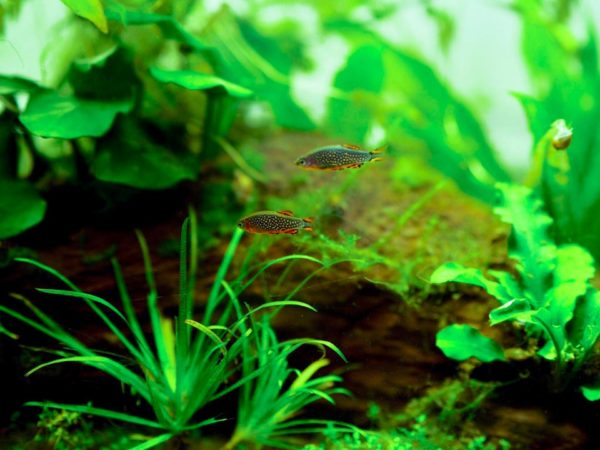
The recommended tank size for Galaxy Rasbora is 10 gallons or 20″ x 10″ x 12″ inches. Depending on the number of fish, we recommend a bigger tank size. The more space they have, the better they will live.
Tank Shape for Galaxy Rasbora
A long, 10-gallon or more tank with plenty of space at the bottom will be an excellent place for a school of Galaxy Rasbora. It will provide a more extensive surface area to decorate with plants and rocks, essential, frequent and they will enjoy it more. They are also suitable for nano tanks due to their small size.
Filter Type
A good filter is needed to check the quality of water from time to time. Invest in a sound filtration system to keep the water temperature and acidity in check.
Substrate
Galaxy Rasboras need a dark substrate. You can make this with rocks and small pebbles as they will resemble a muddy pond bottom. They spend most of their time at the bottom scavenging for food, so you can bury a lot of vegetation under the substrate to keep them entertained.
How many Galaxy Rasboras can live in a 10-gallon tank?
A 10-gallon tank is compulsory for a school of Galaxy Rasbora even though we would recommend a bigger size. A rule of thumb to follow is to have 2 gallons per fish. You can keep a small to medium-sized school in a 10-gallon tank. After that, increase the size of the tank as the number of fish increases. An ideal size would be a 20 or a 30-gallon tank.
Water Parameters for Galaxy Rasbora
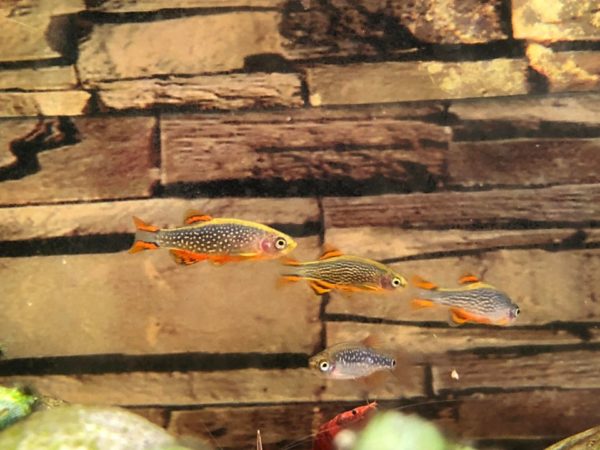
Water Temperature
The perfect water temperature for Galaxy Rasbora is 72 to 73 degrees F. Galaxy Rasboras enjoy warmer water temperatures like most freshwater fish. It is crucial to keep this temperature constant for the well-being of your fish.
Water Flow Rate
Even though the Galaxy Rasbora is easy to care for, they will fall sick if the water quality is poor or if the water movement is too fast. They prefer a slow water movement, which is best for them to thrive.
pH Level
The perfect water pH level for Galaxy Rasbora is 6.5 to 7.5. They prefer a less acidic and slightly neutral acidity level. They are pretty sensitive to the changes in pH, so make sure that you give special attention to this.
Water Hardness
The key to a healthy tank for Galaxy Rasbora is maintaining a water hardness of 2 to 10 dKH. Galaxy Rasboras will thrive in slightly hard water. It is essential to do your research before getting new freshwater fish as each of them thrives in different water conditions.
Because the fish need to stay in a clean environment, frequent water changes at least once a week are advisable. You can do this by changing a quarter of the water and also doing filtration.
Galaxy Rasbora Tank Landscape
An aquarist can hope to recreate the species’ natural environment to create the safety net for any creature to feel at home. For Galaxy Rasbora, that environment is slow-moving water with dense vegetation and plenty of places to hide.
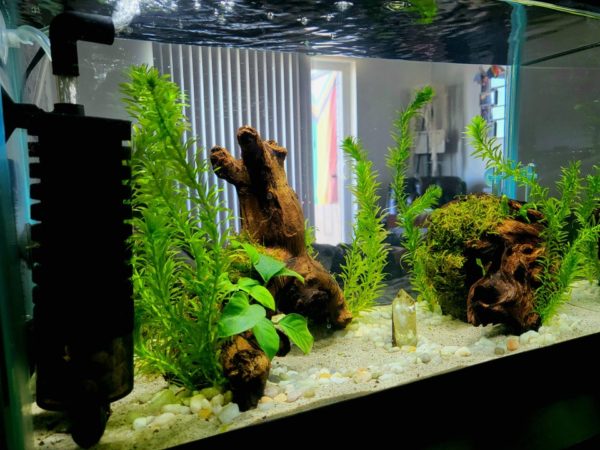
Best Plants for Galaxy Rasbora Tanks
Galaxy Rasboras are small, and so they do not need a lot of space to swim around. It m in the tankLightans you can heavily plant your tank. Make sure to use a lot of plants around the tank because they will use these as places to hide and sleep. As long as these plants give cover and let in sunlight, they should be fine. Some plants that you can keep in a Galaxy Rasbora tank are:
- Anubias
- Vesicularia
- Hygrophila
- Weeping moss
- Rotala Macrandra
- Ludwigia
Worst Plants for Galaxy Rasbora Tanks
Plants that are non-toxic and aquatic will be the best bet for the tank. However, there are some plants to avoid in a Galaxy Rasbora tank. These are:
- Daphne
- Caladium
Make sure to check whether the plants you add can withstand the water conditions suitable for the tank.
Decorations for Galaxy Rasbora Tanks
Mixing these plants with other items for decor such as driftwood, leaf litter, or pieces of rock, is an excellent addition to any tank. Adding fake plants, live plants, fake props, floating vegetation, or colorful gems and stones keeps the fish engaged, as they love playing hide and seek around these massive structures. They will also have multiple hiding places, which will replicate their natural environment.
Lighting for Galaxy Rasbora Tanks
The Galaxy Rasbora is famous for needing a vast amount of sunlight. In the tank, lighting should be moderate, but it should not be a significant concern because they direct sun-lit ponds even in the wild. In case your tank does not get enough natural sunlight, then consider using a bright bulb. You should also do this for otherwise dark areas.
Feeding Galaxy Rasbora
Galaxy Rasboras are omnivorous, feeding on both plant and animal matter. In their natural habitat, they consume algae, shrimp, and similar foods. In aquariums, they can be fed small live foods like micro-worms, brine shrimp, and Daphnia, as well as crumbled fish flakes and Tetra mini granules. Sinking pellet food is recommended for these bottom-dwelling fish. A balanced diet can be maintained by occasionally providing treats like white worms. Feeding should occur twice daily, or three times for younger fish.
Best Diet for Galaxy Rasbora
Galaxy Rasboras are omnivorous. That is, they feed on both plants and other animals, such as invertebrates. In their natural habitat, they are always looking for food. They eat everything from algae to shrimp.
You can feed them tiny live foods such as micro-worms, brine shrimp, and Daphnia. Feeding them small crumbled fish flakes, tetra mini granules, and live Tubifex will also prove a good nourishment source. Make sure that you are providing them with constant food in the form of pellets or flakes.
Galaxy Rasboras are shy, so feeding them might be difficult initially. They do not come up to the tank surface. To overcome this, get sinking pellet food for them. Also, make sure that other tank mates or top swimmers are not eating their food before reaching the bottom-dwelling Galaxy Rasboras.
As a treat, you can also feed them white worms, brine shrimp, etc. To give them a balanced diet, keep changing up their food items.
How often should you feed Galaxy Rasbora?
You should typically give the Galaxy Rasbora food two times a day. When they are young, provide them three times a day.
Galaxy Rasbora Behaviour and Temperament
Galaxy Rasboras are small and timid creatures. They are shy and do not interact much with other fish, more significant than them. This behavior makes them a peaceful companion to most freshwater fish. They can live well in community tanks, but they need a lot of places to hide.
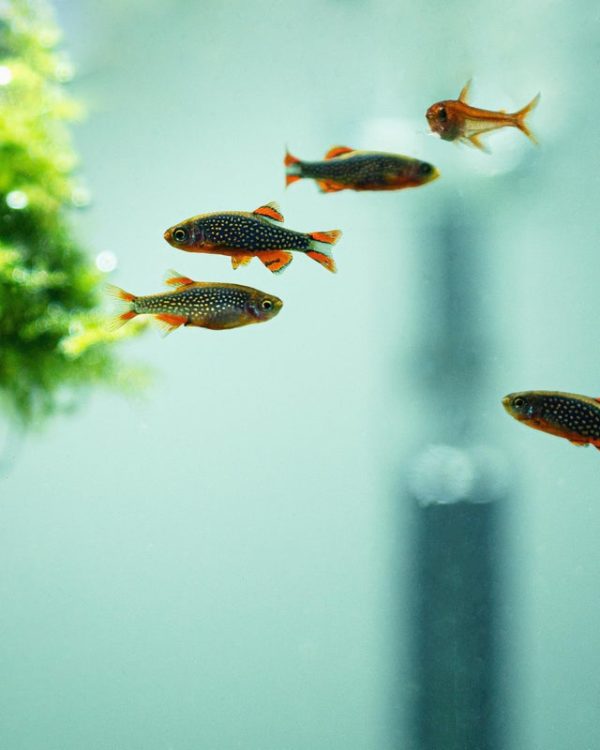
We advise you to keep them in large schools because they will feel more protected and safe. Keeping more of them together will help them overcome their shyness and interact more.
Galaxy Rasboras swim near the bottom of the tank most of the time. They do this because they are always on the lookout for food. They also love playing around with the plants and rocks in the tank, so make sure that there are enough places for them.
In the wild, they are used to living in thick vegetation. So try to mimic that in the tank by planting a lot of plants.
Is Galaxy Rasbora lone or societal?
They are the most societal amongst their school. Owing to their shyness, they do not interact more with other species. The reason for this behavior could also be because of their small size. To make sure they feel comfortable, keep them in a school.
Galaxy Rasbora Tank Mates
Ideal Galaxy Rasbora Tank Mates
You can put other tank mates with them, but just ensure they are not overly temperamental and aggressive. The Galaxy Rasbora is generally a peaceful fish and will not attack other fish of the same size or smaller. You can also get some top-dwellers. Some good tankmates for a Galaxy Rasbora tank are:
- Danio Erythromicron
- Pygmy Hatchetfish
- Killifish
- Molly fish
- Honey Gourami
- Sparkling Gourami
- Red cherry shrimp
- Tetras (Such as Neon Tetras, Green tetras, Ember Tetras, etc.)
- Guppies
- Corydoras catfish
- Amano Shrimp
- Endler’s livebearer
Bad Tank Mates for Galaxy Rasbora
We do not recommend aggressive fish for a Galaxy Rasbora tank. Some bad tank mates are:
- Angelfish
- Cichlids
- Oscars
- Jack Dempseys
- Other large fish
Breeding Galaxy Rasbora
The female of the Galaxy Rasbora is known to scatter eggs when it is time for breeding, and then the male will go over the eggs to fertilize. During this period it is best for the water in the tank to be made soft with minimal lighting.
Some of the things you can do to aid the fish in breeding successfully in the tank are
providing a shallow tank fitted with an air-driven sponge filter. You can also set the tank temperature to be approximately 24°C. You can then introduce the female and male into the tank.
Essentially, you may not need to condition the male and the female to start spawning, but providing them with lots of live food or frozen food will help speed things up.
It is the males that usually initiate the breeding process. In most instances, you will see the male starting to show some sort of dance near the female. The dance is an attempt to persuade the female to start laying the eggs.
As soon as the female lays eggs and deposits them on the spawning mop provided for them, the male will then hover over them to fertilize. Please note that the female will not lay too many eggs at once, but it is a process that may take a few hours, with the male repeating the same thing over.
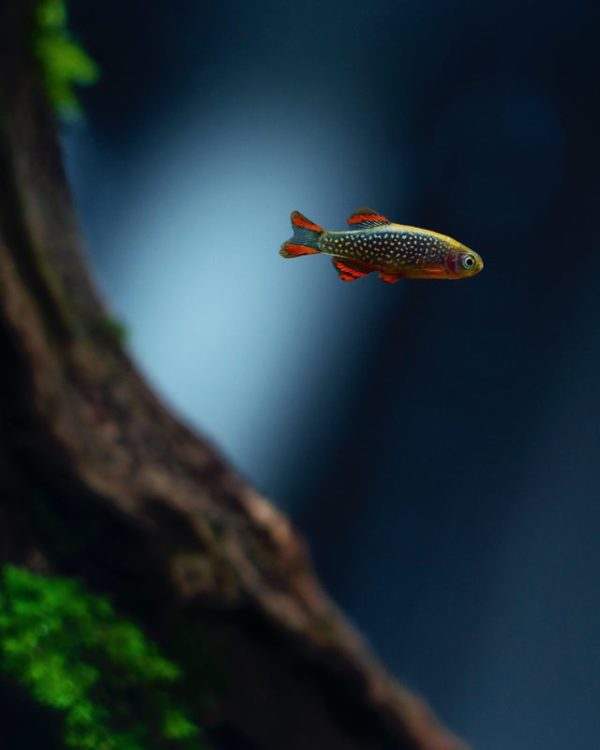
Once you are sure that the spawning and fertilization are complete, remove the adult fish from the breeding tank. This practice will help avoid the possibility of the male and even the female from feeding on the fry that will hatch in 24 hours after successful fertilization.
Galaxy Rasbora Breeding Level – Easy
Galaxy Rasbora Sexual Dimorphism?
To distinguish between male and female Galaxy Rasbora, we need to look at the color of the fish. The male Galaxy Rasboras are brighter than females. Males also have fins with streaks on them.
Galaxy Rasbora Common Diseases and their Treatment
Being freshwater fish, Galaxy Rasboras bring about diseases with them. Most of the time, aquarists are late in spotting these illnesses because the fish are small. You should treat these diseases immediately and seriously. Here are some common diseases that affect Galaxy Rasbora and how to cure them:
Fin Rot
Galaxy Rasboras are affected by this disease because of infighting. Wounds or cuts resulting from these clashes cause Fin Rot. A simple solution to this is to maintain a balanced ratio of males to females. The symptoms can worsen due to other tank factors like bacteria, pathogens, etc.
Ich or White Spot Disease
White Spot Disease causes respiratory problems in the fish. They will show restless behavior, but most importantly, white spots on the body of the fish. This symptom will go away once the water conditions are ideal. Other symptoms will include lethargy, and the fish will stop eating. Since this is a common disease, you can also opt for over-the-counter medications to treat them.
You can prevent any other diseases by maintaining the proper water temperature and hygiene in the tank.
Facts about Galaxy Rasbora
- Galaxy Rasboras were discovered in 2006, making them a relatively recent discovery.
- They natively belong to the South East of Asia.
- Galaxy Rasboras are famous for their brilliant colors and peaceful nature across the world.
- They have many other names such as Celestial Pearl Danio, Fireworks Rasbora, Microrasbora sp, Celestichthys Margaritatus, and Chilli Rasbora.
- It is one of the smallest freshwater fish in size, growing only up to 1 or 1.5 inches.
- It became rare just six months after having been discovered. Today, it is widely available around the world though they are all captive-bred.
Is Galaxy Rasbora Right For You?
Author’s Note: Galaxy Rasboras are very responsive, comical, and attractive fish. They are effortless to care for and even easier to breed. The only thing to look out for is to make the tank environment secure and suited to their needs. On average, the fish will quickly adjust to varied water conditions and therefore should not prove an arduous task to keep even by a beginning aquarist. Just remember to follow the basic rules of caring for aquarium fish, though.
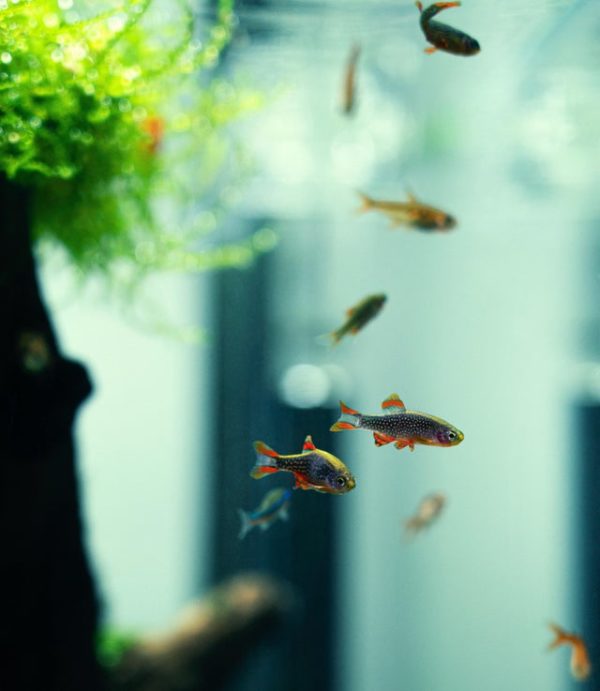
FAQs
Are Galaxy Rasboras Hardy Fish?
The small size of Galaxy Rasboras makes them more susceptible to disease than others. They are still quite hardy, and you can take care of them quickly enough. They will need more special care because they are sensitive to water conditions and infections around them.
Are Galaxy Rasboras Fin Nippers?
They do nip fins off each other, but that doesn’t necessarily make them fin-nippers. This behavior only happens when the Galaxy Rasboras are fighting amongst themselves. Usually, it is because of the lack of females in the tank.
Are Galaxy Rasboras Aggressive?
Galaxy Rasboras are not aggressive at all. They will shy away and hide under dire circumstances. Only the males of this species might show some aggression when they are breeding or when they are fighting over the females. Sometimes, it may also happen due to the lack of food. Otherwise, aggression is a rare sight in a Galaxy Rasbora tank.
How Many Rasboras Should be Together?
It would be safe to keep 5 to 6 Galaxy Rasboras with an equal distribution of males and females in a 10-gallon tank. They are schooling fish, so they should ideally be kept in larger groups. Add 2 gallons of extra space with every new Galaxy Rasbora you add to the tank.
Can Galaxy Rasboras Live With Bettas?
Bettas are one of the ideal tank mates of the Galaxy Rasboras. In the wild, they do co-exist. In a confined home aquarium, you will need to make sure that you meet the water conditions and dietary needs. If they do, then you can place them together.
Conclusion
The Galaxy Rasbora could be a fantastic choice of fish for you if you have a communal tank or desire a single-species nano tank. These odd little fish are an excellent alternative to more regularly encountered small community species like tetras and guppies. They are easy to care for and make for a beautiful pet to anyone. An attractive feature about them is that they look like multiple streaks of red flitting about in the aquarium. If you are just starting, then the shy Galaxy Rasbora would be a perfect option for you. They make for an excellent fish-watching experience.
No related posts.

1 thought on “Galaxy Rasbora: Full Care Guide, Breeding, Tank Size & Disease”
This site was so useful for informing me on how to care for the Galaxy Rasbora but I’d like to know how many fry i should expect to see off each mating pair?